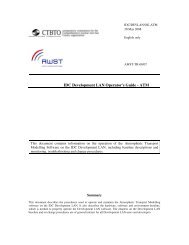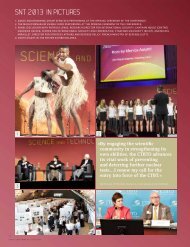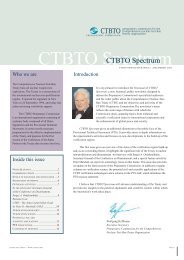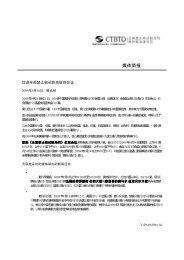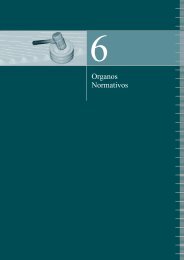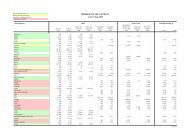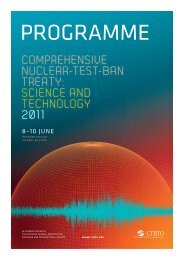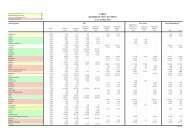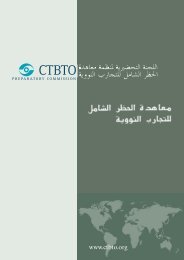ctbto Spectrum
ctbto Spectrum
ctbto Spectrum
You also want an ePaper? Increase the reach of your titles
YUMPU automatically turns print PDFs into web optimized ePapers that Google loves.
Cover storyNuclear Dangers: The Race between Cooperation and Catastropheby Sam NunnAt the dawn of the nuclear age – afterthe devastation of Hiroshima andNagasaki – General Omar Bradley said:“The world has achieved brilliance withoutwisdom...We know more about war thanwe know about peace, more about killingthan we know about living.”It might surprise General Bradley, if hewere alive today, to know that we have made it60 years without a nuclear attack. We were good,we were diligent, but we were also very lucky.Making it through 60 years without anuclear attack should not make us complacent.If we’re to continue to avoid a catastrophe,all nuclear powers will have to be highlycapable, careful, competent, rational – and ifthings go wrong, lucky – every single time.The world is heading in avery dangerous directionWe do have important efforts underway andsome important successes, but the risk of anuclear weapon being used today is growing,not receding. The storm clouds are gathering:▪ Terrorists are seeking nuclear weapons,and there can be little doubt that if theyacquire a weapon that they will use it.▪ There are nuclear weapons materials inmore than 40 countries, some secured bynothing more than a chain link fence.▪ A number of countries are consideringdeveloping the capacity to enrich uraniumto use as fuel for nuclear energy, butthis would also give them the capacityto move quickly to a nuclear weaponsprogram if they chose to do so.▪ Meanwhile, the United States andRussia continue to deploy thousands ofnuclear weapons on ballistic missilesthat can hit their targets in less than30 minutes, encouraging both sides tocontinue a prompt launch capabilitythat carries with it an increasinglyunacceptable risk of an accidental,mistaken or unauthorized launch.The bottom line: The world isheading in a very dangerous direction.New vision for our globalnuclear policyWith these growing dangers in mind, formerU.S. Secretaries of State George Shultz andHenry Kissinger, former U.S. Secretary ofDefense Bill Perry and I published an op-edin January 2007, and a follow-up piece in2008, in The Wall Street Journal that calledfor a different direction for our globalnuclear policy with both vision and steps.The four of us, and the many othersecurity leaders who have joined us, arekeenly aware that the quest for a nuclearweapon-freeworld is fraught with practicaland political challenges. We have takenaim at the practical problems by linkingthe vision of a nuclear-weapon-free worldwith a series of steps for reducing nucleardangers and carving a path towards aworld free of the nuclear threat.Without the bold vision, the actionswill not be perceived as fair or urgent.Without the actions, the vision will notbe perceived as realistic or possible.We don’t believe our example is likelyto inspire Iran, North Korea or al Qaeda todrop their weapons ambitions, but we believeit would become more likely that many morenations will join us in a firm approach tostop the proliferation of nuclear weapons andmaterials and prevent catastrophic terrorism.I believe that we cannot defend ourselvesagainst the nuclear threats facing the worldtoday without taking these steps. We cannottake these steps without the cooperation ofother nations. We cannot get the cooperationof other nations without the vision andhope of a world that will some day endthese weapons as a threat to mankind.Strategic cooperationagainst nuclear weaponsThis will be a challenging process that mustbe accomplished in stages. The United Statesmust keep nuclear weapons as long as otherUS senior statesmen George Shultz, William Perry, Henry Kissinger andSam Nunn renewed their call for a nuclear-weapon-free world by supporting,among other measures, the adoption of a process for bringing the CTBTinto effect, “which would strengthen the Nuclear Non-Proliferation Treaty(NPT) and aid international monitoring of nuclear activities. This calls for abipartisan review, first, to examine improvements over the past decade of theinternational monitoring system to identify and locate explosive undergroundnuclear tests in violation of the CTBT; and, second, to assess the technicalprogress made over the past decade in maintaining high confidence in thereliability, safety and effectiveness of the nation’s nuclear arsenal under atest ban. The Comprehensive Test Ban Treaty Organization is putting in placenew monitoring stations to detect nuclear tests – an effort the U.S shouldurgently support even prior to ratification.”Opinion Editorial, Wall Street Journal, 15 January 2008pa g e C T B T O S p e c t r u m 9 | w w w. c t b t o . o r g



